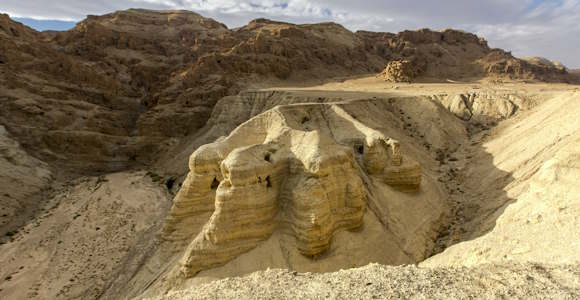
First Editions of the Bible Discovered by Artificial Intelligence and Chemistry
AI and chemistry break with tradition and reveal surprising early dates for the world’s oldest biblical manuscripts; the Dead Sea Scrolls
Since their discovery in 1947, the Dead Sea Scrolls have been central to our understanding of the origins of Judaism and Christianity. But one major question has remained unanswered: when exactly were the individual texts written?
Now, an international team of researchers, led by the University of Groningen with contributions from SDU, has found the answer. Using advanced radiocarbon dating, artificial intelligence, and handwriting analysis, they have developed a groundbreaking AI tool capable of dating the Dead Sea Scrolls and other ancient manuscripts. The tool is called Enoch.
The team is led by Professor Mladen Popović of the Qumran Institute at the University of Groningen. Other contributors are from the University of Groningen, the University of Pisa in Italy, KU Leuven in Belgium, and the University of Southern Denmark. The work is funded by the European Research Council project “The Hands That Wrote The Bible” and is now published in the journal PLOS One.
Older Than Previously Assumed
Using Enoch, the researchers now conclude that many of the Dead Sea Scrolls are older than previously assumed. Two of the fragments can even be dated all the way back to the time when their presumed biblical authors lived, which in that case makes them something as rare as “first editions” of the Bible.
“This is probably the most unexpected result – that two of the texts turned out to be first editions,” says Professor Emeritus Kaare Lund Rasmussen from the Department of Physics, Chemistry and Pharmacy, who contributed to the study by de-contaminating the scroll samples.
Until now, dating of the Dead Sea Scrolls has primarily relied on palaeography – the study of ancient handwriting. This method is marked by subjectivity and a lack of calibration points. In this project, the researchers therefore took new samples from the parchments and carbon-14 dated them. But before they could do that, the parchments had to be cleaned of the castor oil that had been applied to them in the 1950s in an attempt to preserve them. This is where Kaare Lund Rasmussen was brought in.

“I was responsible for cleaning the samples - that is removing the castor oil. I received fragments weighing about 10 milligrams from Israel, which were transported via Groningen by courier to our laboratory in Odense. Here, we removed the oil using a method we developed ourselves. Developing the method took many years, and we conducted several experiments before finding an effective and sufficiently gentle cleaning process,” he explains.
The cleaning was subsequently validated at the University of Pisa, and the cleaned samples were then sent back to Groningen for carbon-14 dating.
With the new carbon-14 datings in hand, the researchers began training their AI tool Enoch to read the specific features of the handwriting and assign a date. Enoch analyzed all the details of the handwriting – such as the microscopic curves in ink traces and the shapes of entire letters – and was thereby able to determine the age of the texts with a precision of plus/minus 30 years.
135 Manuscripts Analyzed
“It is the first time an objective method has been used to date manuscripts based on the writing itself. It is very satisfying that our many years of chemical groundwork helped make this possible,” says Kaare Lund Rasmussen.
Enoch was used to analyze 135 manuscripts and achieved a success rate of about 79 percent, measured by palaeographers independently agreeing with Enoch’s datings. According to the research team, this makes Enoch an important new scientific tool – and potentially a game-changer for the study of ancient texts.
“Using Enoch, we were able to date 135 other scrolls without cutting into them at all. The implications of this are obviously enormous for dating other ancient manuscripts,” says Kaare Lund Rasmussen.
Teacher of Righteousness and the Wicked Priest
Among the results is a particularly sensational discovery: The two fragments 4QDanielc and 4QQoheleta turn out to have been written at roughly the same time as their presumed authors lived – thus making them a kind of “first editions” of biblical texts.
“Normally, we only have later copies of biblical texts. But here, we’re looking at something that very well may be the original versions. It’s like finding a first edition of the Bible in its original form,” says Kaare Lund Rasmussen.
The researchers hope the new datings can also shed light on the question of when and how the mysterious desert sect at Qumran arose – the group that most likely wrote the Dead Sea Scrolls. Although we still don’t know the identities of figures like the “Teacher of Righteousness” or the “Wicked Priest,” the new dating techniques bring us closer to understanding the power struggles and historical events that took place in the Judean Desert in the centuries leading up to the Common Era, the researchers believe.
Meet the Researcher
Kaare Lund Rasmussen is Professor Emeritus of Chemistry and Archaeometry at the Department of Physics, Chemistry and Pharmacy. His expertise is chemical analyses of cultural heritage materials. Since the mid-1990s, he has worked on the Dead Sea Scrolls, and he has also analyzed artifacts such as the shrine of King Canute the Holy, the hair and bones of Tycho Brahe, as well as various relics associated with Francis of Assisi and the Apostles of Jesus. He is co-author of the book “Arkæometri: Undersøgelser af kulturarv”, published by Orbis.